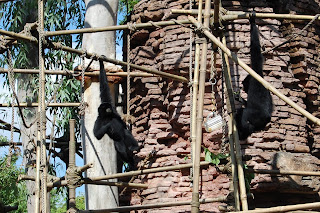The tight, winding streets of Anandapur Township, which make up much of the queue for Kali River Rapids, are lined with street vendors peddling their wares to tourists and locals alike. There are farmers, basket weavers, punched tin artists and more.
Most of the props that you see in these vignettes are authentic. So much so, in fact, they were acquired directly from real street vendors in Asian villages where the Imagineering team traveled for research. On more than one occasion, the team actually purchased every single item a vendor had, including his bicycle and even the tiny chair on which he would rest between customers. Don't feel bad for that anonymous entrepreneur, though. The money he earned in exchange likely supported his family for a year.
A common sight in this part of Asia is a bird market, where one can find dozens of bird cages filled with feathered stock. Here in Anandapur, the Imagineers tried to capture the impression of the bird market... only without the birds. While birds can be seen and heard nearby in proper aviaries, it would have been against Disney's animal care practices to keep so many cooped up in such small quarters (no matter how authentic to the story that may have been).
Among the streets and vendors can also be found more of those wonderful place-making graphics, implying a rich and detailed world beyond what we can visit within the park. Need Anandapur currency? There's apparently a "money changer" just around the corner from the bird market.
Looking for a place to stay? May we recommend Ekt's Hotel? They offer cheap prices, a friendly staff, nice views, fans in most rooms and a bathroom with running water on both floors. Of course, for those seeking luxuries, a mattress and toilet paper are "just a little extra."


















































